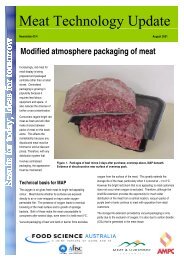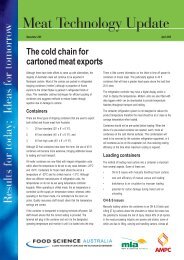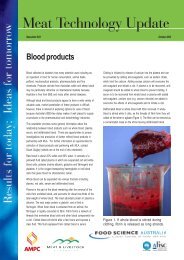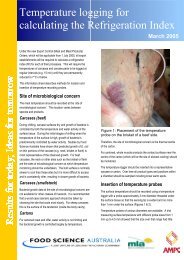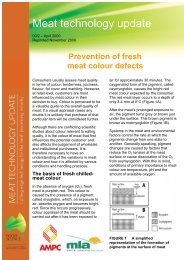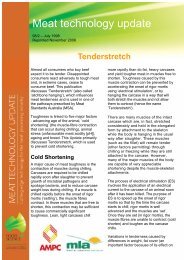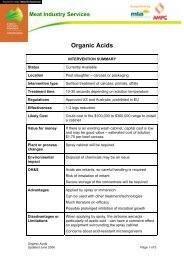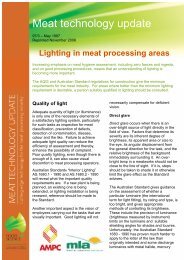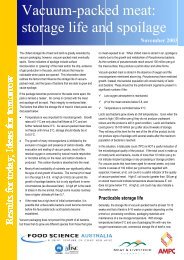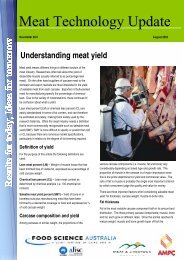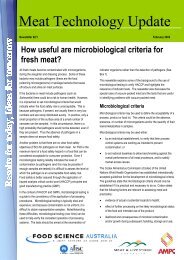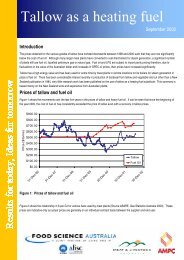Production factors affecting beef eating quality - Red Meat Innovation
Production factors affecting beef eating quality - Red Meat Innovation
Production factors affecting beef eating quality - Red Meat Innovation
Create successful ePaper yourself
Turn your PDF publications into a flip-book with our unique Google optimized e-Paper software.
<strong>Meat</strong> technology update<br />
00/4 – August 2000<br />
Reprinted November 2006<br />
<strong>Production</strong> <strong>factors</strong><br />
<strong>affecting</strong> <strong>beef</strong> <strong>eating</strong> <strong>quality</strong><br />
Previous <strong>Meat</strong> Technology Update<br />
Newsletters (99/4 and 99/6—see Further<br />
Reading) have dealt with the influence of<br />
pre- and post-slaughter <strong>factors</strong> on <strong>beef</strong><br />
<strong>eating</strong> <strong>quality</strong>. This final newsletter in a<br />
series of four focuses on the on-farm, or<br />
production-based, <strong>factors</strong> that have been<br />
shown to affect <strong>beef</strong> palatability.<br />
There are a lot of misconceptions about<br />
what governs <strong>beef</strong> palatability. Most<br />
relate to the relevance of the on-farm<br />
<strong>factors</strong> (e.g. breed, nutrition, growth path,<br />
fatness etc.) that, historically, have<br />
generally been overstated. That is not to<br />
say that <strong>factors</strong> like breed and growth<br />
path do not have a bearing on palatability<br />
traits like tenderness. Rather, some of<br />
the previous estimates of the magnitude<br />
of these effects were often confounded,<br />
owing to a lack of control of the postslaughter<br />
environment. Only recently<br />
have these effects been more accurately<br />
defined through the research of the<br />
Cattle and Beef Industry Co-operative<br />
Research Centre (CRC) and <strong>Meat</strong><br />
Standards Australia (MSA).<br />
With the aim to predict <strong>eating</strong> <strong>quality</strong>, a<br />
logical approach is to identify which<br />
<strong>factors</strong> are relevant to each muscle. The<br />
<strong>eating</strong> <strong>quality</strong> of each muscle will be<br />
determined by a number of <strong>factors</strong>,<br />
including:<br />
• the amount of connective tissue;<br />
• fat content;<br />
• muscle-fibre shortening/stretching<br />
during rigor mortis;<br />
• post-rigor ageing/tenderisation.<br />
Given these variables, it follows that<br />
there will be fundamental differences in<br />
the palatability of different muscles within<br />
the carcase and that these relationships<br />
will vary, depending on the production,<br />
pre-slaughter and post-slaughter<br />
conditions. Moreover, it is important to<br />
recognise that the influence of any single<br />
production factor may not be constant<br />
across all muscles.<br />
The production <strong>factors</strong> covered in this<br />
newsletter include:<br />
• within-breed and between-breed<br />
variation;<br />
• sex;<br />
• fatness;<br />
• age;<br />
• nutrition and growth path.
Breed<br />
Within-breed variation<br />
Initial estimates from the CRC indicate that<br />
under the slaughter protocol used by the<br />
CRC there is limited genetic variation in<br />
tenderness (shear force) for Bos taurus<br />
breeds, although there appears to be much<br />
more genetic variation in the tropically<br />
adapted breeds (e.g. Belmont <strong>Red</strong>s, Santa<br />
Gertrudus, and Brahman). These results<br />
therefore suggest that there is little<br />
opportunity for genetic improvement in<br />
tenderness within Bos taurus breeds.<br />
Greater scope for change exists in the case<br />
of the tropically adapted breeds.<br />
Between-breed variation<br />
The debate regarding the significance of<br />
breed in relation to <strong>beef</strong> <strong>eating</strong> <strong>quality</strong> has<br />
attracted considerable controversy. Most has<br />
centred on the issue of Bos indicus content,<br />
with the debate intensifying following the<br />
initial decision by MSA to exclude cattle with<br />
greater than 25 per cent Brahman content.<br />
Whilst the new MSA cuts-based system is far<br />
less restrictive in that the full range of Bos<br />
indicus content is eligible for grading, there is<br />
still a negative association between Bos<br />
indicus content and <strong>eating</strong> <strong>quality</strong> within the<br />
prediction model.<br />
A number of researchers (both overseas and<br />
Australian) have reported that as Bos indicus<br />
percentage increases, tenderness or<br />
palatability of the meat decreases. The<br />
magnitude of the breed effect tends to vary<br />
considerably between studies and is<br />
probably linked to differences in the<br />
management or the processing conditions<br />
during slaughter. Certainly individual studies<br />
by the CRC show that under carefully<br />
controlled conditions, Bos indicus content up<br />
to 75% may have only a small impact on<br />
palatability.<br />
Another joint CRC/MSA study has also<br />
shown that the Bos indicus effect is not<br />
constant across all muscles in the carcase.<br />
Notably, the effect was more pronounced in<br />
the high <strong>quality</strong> loin cuts (striploin, cube roll<br />
and tenderloin), suggesting that the effect is<br />
more myofibrillar in origin. These muscles,<br />
being predominantly postural, are typically<br />
low in connective tissue.<br />
Various suggestions have been made as to<br />
why Bos indicus cattle have less tender<br />
meat. These include the effect of the<br />
production environment given that Bos<br />
indicus cattle are typically raised in harsher<br />
environments. This, in turn, results in<br />
variable growth rates (possible direct effect<br />
on muscle structure and composition),<br />
increased age at slaughter (increased<br />
collagen-related toughness) and leaner and<br />
lighter carcases (increased risk of cold<br />
shortening if not controlled). Other theories<br />
have arisen from observed breed differences<br />
in the intrinsic properties of the muscle.<br />
Prominent amongst these is the difference in<br />
activities of enzymes responsible for the<br />
tenderising effect when meat is aged. More<br />
precisely, the inhibitor to these enzymes,<br />
calpastatin, is higher in activity in the<br />
muscles of Bos indicus cattle, thus retarding<br />
the ageing process. However, even though<br />
differences in the protein-breakdown<br />
(proteolytic) activity have been found, they<br />
haven’t always coincided with different rates<br />
of tenderisation as measured by consumer<br />
panels or by shear-force measurements,<br />
particularly when the post-slaughter<br />
environment has been controlled.<br />
Sex<br />
Small differences in palatability have been<br />
observed between the sexes. Beef from bulls<br />
can be more variable and this is often<br />
associated with the higher variability in<br />
ultimate pH. Consequently, male cattle<br />
showing secondary sex characteristics—<br />
physical characteristics of a bull—have been<br />
excluded under the MSA system. Past<br />
comparisons between steers and heifers<br />
suggest that the <strong>beef</strong> <strong>quality</strong> was similar.<br />
However, preliminary analyses of the MSA<br />
data indicate a small, yet consistent, sex<br />
effect, with heifers having lower <strong>eating</strong><br />
<strong>quality</strong> scores than steers. Reasons for this<br />
effect are not clear at this stage.<br />
Fatness<br />
The fatness of the carcase can exert indirect<br />
and direct effects on <strong>beef</strong> <strong>eating</strong> <strong>quality</strong>. The<br />
2
indirect effect is associated with the inverse<br />
relationship between the fatness of the<br />
carcase and the rate at which the carcase<br />
cools (i.e. fatter carcases will cool at slower<br />
rates compared to leaner carcases). Any<br />
variances in cooling rate relative to the pH<br />
decline (refer <strong>Meat</strong> Technology Update<br />
Newsletter 99/1) will lead to differences in<br />
the degree of muscle shortening and<br />
consequently, tenderness/toughness.<br />
The direct effect of marbling on <strong>eating</strong> <strong>quality</strong><br />
has attracted considerable debate in the<br />
past. Much of this centred on the contention<br />
that greater marbling always resulted in more<br />
tender meat. Whilst this could be<br />
demonstrated, this was largely due to the<br />
indirect effect of carcase fatness on<br />
tenderness rather than marbling per se. In<br />
other words, marbled <strong>beef</strong> was typically<br />
derived from heavy, fat carcases in which the<br />
likelihood of cold shortening was minimal, in<br />
view of the slower cooling rates observed for<br />
these carcases. In stimulated carcases<br />
(where cold shortening did not occur)<br />
marbling had only a small effect on<br />
tenderness. Recent results from consumer<br />
panels indicate that the direct link between<br />
marbling and palatability is through<br />
enhanced juiciness and flavour.<br />
Animal age<br />
The chronological age of the animal is<br />
important in the context of meat tenderness.<br />
Typically, with increasing animal age, the<br />
connective tissue contribution to tenderness/<br />
toughness increases as a result of the<br />
increased crosslinking within the connective<br />
tissue. Dentition scores relating to the<br />
eruption of permanent incisor teeth is used to<br />
estimate, albeit crudely, animal age.<br />
Ossification<br />
Physiological age can be estimated by the<br />
degree of ossification (calcification) that<br />
occurs in the chine bones and during fusion<br />
of the vertebrae. As the animal ages, the soft<br />
cartilage tips of the spinous processes of the<br />
vertebrae (chine bones) calcify or harden.<br />
However, like dentition, the relationship<br />
between the degree of ossification and age<br />
can vary considerably. This, to a large<br />
degree, is related to the growth history of the<br />
animal and ossification is believed to provide<br />
a more informative perspective on the<br />
physiological maturity of the animal. Animals<br />
that endure restricted growth show advanced<br />
ossification at the same age compared with<br />
animals that have been raised on a good<br />
plane of nutrition. Therefore, by knowing the<br />
ossification score and the weight of the<br />
animal, it is possible to draw some<br />
conclusions about the production history of<br />
the animal.<br />
Why is this important The data indicates<br />
that at the same carcase weight, there is an<br />
inverse relationship between ossification<br />
score and <strong>eating</strong> <strong>quality</strong>. The nature of this<br />
relationship will vary, depending on how the<br />
carcase was processed, but it shows that, as<br />
the ossification score increases, there is a<br />
slight loss in <strong>eating</strong> <strong>quality</strong>. There are a<br />
number of plausible reasons for this effect;<br />
however they have not been validated at this<br />
stage.<br />
The MSA scale of ossification goes from 100<br />
to 200 in 10-point increments. With the<br />
present system, a maturity score of 200 is<br />
the cut-off as a means to exclude older<br />
animals. In cattle that have followed a normal<br />
growth path, an MSA ossification score of<br />
200 would generally refer to an animal of<br />
about 30 months of age.<br />
The vertebrae of the backbone—specifically<br />
the cartilage between and on the dorsal<br />
edges of the sacral, thoracic (called buttons),<br />
and lumbar vertebrae —are assessed (the<br />
cervical vertebrae are not considered). All of<br />
these cartilage areas are considered in<br />
arriving at a level of maturity. The sacral and<br />
lumbar cartilages are least ossified in the<br />
youngest carcases, as are the buttons, which<br />
are also prominent and soft. Ribs can also<br />
be used to assess physiological age. They<br />
tend to be round and narrow in young<br />
animals and flat and wide in older ones.<br />
Young animals have red-coloured ribs<br />
because they are involved in marrow, redblood-cell<br />
manufacture. As the animals get<br />
older, this activity decreases and their ribs<br />
become correspondingly whiter.<br />
3
As an example, a maturity score of 100<br />
indicates a carcase with no ossification of the<br />
cartilage and clearly defined spinous<br />
processes in all regions, including the sacral<br />
chine bones. Figure 1 shows the degree of<br />
ossification in a carcase with an ossification<br />
score of 100. Note that there was no<br />
ossification in the cartilage that was present<br />
both between the vertebrae and above the<br />
spinous processes. A more detailed view of<br />
the sacral region of an MSA ossification<br />
score of 100 is shown in Figure 2.<br />
In the absence of other influences, the<br />
younger the physiological age of the animal,<br />
the more tender the meat will be. As an<br />
animal gets older, the connective tissues<br />
become more resistant to breakdown during<br />
cooking. This manifests as toughness. With<br />
increased physiological age, the transition<br />
from tender meat to tough meat is gradual<br />
and occurs at different rates in different<br />
muscles.<br />
Nutrition and growth path<br />
FIGURE 1<br />
FIGURE 2<br />
MSA ossification score of<br />
100 (vertebral column)<br />
MSA ossification score of<br />
100 (sacral vertebrae)<br />
It is often very difficult to estimate the ‘true’<br />
effects of the type of nutrition an animal<br />
receives and its rate of growth, as these are<br />
generally confounded. In other words,<br />
animals on higher <strong>quality</strong> feed will generally<br />
grow at faster rates and vice versa.<br />
Moreover, these <strong>factors</strong> will also impact on<br />
the degree of carcase fatness and animal<br />
age at slaughter, which, as stated earlier, will<br />
have both indirect and direct effects on<br />
palatability.<br />
Results from the CRC and MSA indicate that<br />
the rate and pattern of growth impacts on<br />
meat tenderness/toughness. However, it<br />
must be emphasised that the relationship<br />
between growth rate and <strong>eating</strong> <strong>quality</strong> could<br />
not be classed as strong. Rather, there is<br />
considerable variation surrounding this<br />
relationship and much of this can be linked to<br />
the fact that growth rate does not necessarily<br />
describe the growth pattern of animals.<br />
Cattle rarely grow at constant rates: there<br />
are often periods of no growth, slow growth<br />
and rapid growth, depending on the<br />
nutritional quantity and <strong>quality</strong> of feed. The<br />
timing and duration of these changes are<br />
believed to have a significant impact on the<br />
ultra-structural components within muscle,<br />
which, in turn, manifests as changes in the<br />
meat tenderness/toughness. Changes in the<br />
relative rates of both muscle protein<br />
synthesis and degradation, and connective<br />
tissue structure have been implicated as<br />
reasons for this effect. These mechanisms<br />
and the overall effect of growth pattern on<br />
meat tenderness/toughness will be further<br />
characterised following the completion of<br />
forthcoming investigations within the Cattle<br />
and Beef Quality CRC. However, generally<br />
4
speaking, a high plane of nutrition is<br />
desirable.<br />
Conclusion<br />
There have been a lot of<br />
misconceptions about what governs<br />
<strong>beef</strong> <strong>eating</strong> <strong>quality</strong>. Clearly, the pre- and<br />
post-slaughter conditions are still<br />
paramount. However, when these have<br />
been controlled, we can now quantify<br />
the real magnitude of the production or<br />
on-farm <strong>factors</strong> on <strong>eating</strong> <strong>quality</strong>.<br />
Genetic improvement in tenderness is<br />
feasible but predominantly for the<br />
tropically adapted breeds. Changes in<br />
the rate and pattern of growth will<br />
influence not only carcase composition<br />
with respect to fatness but also the<br />
physiological age at slaughter.<br />
However, the issue of growth path is far<br />
from being fully understood and is the<br />
subject of further research.<br />
Acknowledgements<br />
<strong>Meat</strong> Technology Update Newsletter<br />
99/4, ‘Post-slaughter aspects of <strong>beef</strong><br />
<strong>eating</strong> <strong>quality</strong>’<br />
<strong>Meat</strong> Technology Update Newsletter<br />
99/6, ‘Pre-slaughter aspects of <strong>beef</strong><br />
<strong>eating</strong> <strong>quality</strong>’<br />
<strong>Meat</strong> Technology Update Newsletter<br />
99/7, ‘Beef fat <strong>quality</strong>’<br />
The assistance of the following<br />
organisations in producing this<br />
newsletter is gratefully acknowledged:<br />
• The Cooperative Research Centre<br />
for the Cattle and Beef Industry<br />
(<strong>Meat</strong> Quality)<br />
• <strong>Meat</strong> Standards Australia.<br />
Further Reading<br />
<strong>Meat</strong> Technology Update Newsletter<br />
99/1, ‘A Critical Control Point approach<br />
to <strong>beef</strong> <strong>eating</strong> <strong>quality</strong>’<br />
Contact us for additional information<br />
<strong>Meat</strong> Industry Services is supported by the Australian <strong>Meat</strong> Processor Corporation (AMPC) and <strong>Meat</strong> & Livestock Australia (MLA).<br />
Brisbane: Sydney: Adelaide:<br />
Food Science Australia Bill Spooncer Chris Sentance<br />
PO Box 3312 PO Box 181 PO Box 178<br />
Tingalpa DC QLD 4173 KURMOND NSW 2757 FLAGSTAFF HILL SA 5159<br />
Ian Eustace Neil McPhail Alison Small<br />
T +61 7 3214 2117 T +61 7 3214 211 T +61 7 3214 2109 T +61 2 4567 7952 T +61 8 370 7466<br />
F +61 7 3214 2103 F +61 7 3214 2103 F +61 7 3214 2103 F +61 2 4567 8952 F +61 8 8370 7566<br />
M 0414 336 724 M 0414 336 907 M 0409 819 998 M 0414 648 387 M 0419 944 022



